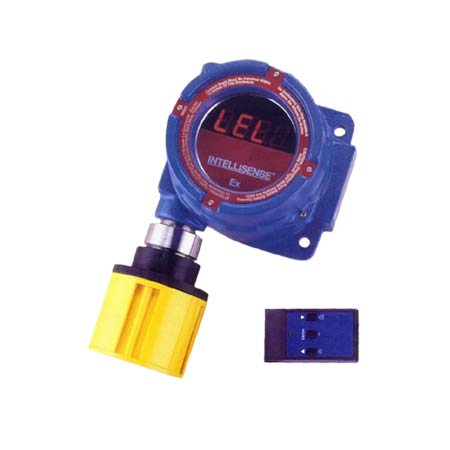Intellisense Remote Sensing Gas Detector
Home | Gas Detectors | Intellisense Remote Sensing Gas Detector
About the Product
Intellisense® Sensing Heads
Combustible and Toxic Gases
Description
The Intellisense is a “stand-alone” remote sensing gas detector for toxic or combustible gases (Ex). It is intended to be placed in the area where leaks of these potential dangerous gases are likely to occur. The Intellisense measures the levels of these gases, activates alarm relays based on the concentration, and transmits an analog or digital signal to the appropriate control device.
An electrochemical toxic or catalytic oxidation (Ex) sensor provides fast, accuracies and specific responses to the gas of concern. The gas concentration is continuously indicated by an LED digital display which is visible through the window of the explosion-proof enclosure. Two on-board fail-safe relays trip, when the user selected gas concentrations are exceeded. One relay can be used to activate horns, lights, or other devices which provide a warning or remedy the situation. The electronics converts the sensor signal into a 4-20mA or optional RS-232 signal or transmission to the controller. a distributed control system (DCS) programmable logic controller (PLC) or other types of centralized control stations.
Intellisense Electronics and Software
The Intellisense electronics and internal software are designed to reduce the concerns and expenses of installation, operation, and maintenance of traditional gas detectors. The on-board relays eliminate the need to lay additional wire from the control system for alarm devices. Alarm level indicators are visible through the display window.
Internal diagnostics continually review operation of the electronics, software, and sensor. Should a fault be detected in any operation of the sensing head, an alphanumeric error message is shown on the LED display and a fault relay is activated. This provides safe operation of the Intellisense sensing head.
The continuous readout feature also displays information or operational and set-up parameters. A microprocessor driven menu guides and instruct the user through all facets of operation. Three push buttons allow the user to select or change any of the conditions such as alarm levels, loop parameters and calibration. All of the Intellisense programmed data is stored on two identical EEPROMs which provide non-volatile memory of this vital information.
All of the microprocessor operations are accessible by a remote, hand-held programmer. The CSA approved intrinsically-safe infared (IR) device allows non-intrusive adjustment of parameters in the field by one person. The programmer is aimed through the display window of the Intellisense and duplicates the functions of the internal buttons. This eliminates the need to declassify hazardous areas during routine procedures like calibration.
To conserve energy when operating from limited power supplies like batteries or solar power; the sleep mode reduces energy requirements of the Intellisense Sensing Head. The sleep mode is indicated by a flashing decimal point on the LED display. When the Intellisense is exposed to concentrations above 1% of the range, the head returns to the normal display mode. Another feature of the sleep mode is security functions. While “sleeping” the electronics cannot be operated by the internal buttons. This prevents tampering of the head and only permits access by those with a remote programmer.
Sensor Technology
TOXIC
High-performance electrochemical Draeger sensors for toxic gases provides long, reliable operation over a wide range of environmental, and application demands. The patented sensor technology can accurately detect most toxic gases and is not adversely affected by high concentrations. The three-electrode design maximizes response to toxic gases while minimizing the effects of other gases. This reduces the amount of false alarms experienced when other gases are present.
A special feature of the Intellisense is an internal temperature compensation circuit. A thermistor is placed with the sensor which minimizes signal drift due to changing ambient temperature conditions.
EX
A catalytic oxidation sensor (pellistor) or Infra Red is used to detect a wide variety of combustible gases and vapours like methane, ethane, hydrogen, etc. The Intellisense combustible gas sensor is approved CSA 152 performance testing criteria. The poison-resistant sensor design minimizes the adverse effects of sulphur, silicon, halogens, and heavy-metal bearing compounds thus providing long and more reliable operation.

Features:
- Patented gas detector sensor technology provides fast, accurate and specific responses to many toxic gases
- Detects a wide range of combustible and toxic gases
- Built-in Warning, Alarm and Fault Relays allow stand-alone operation
- Non-intrusive, one-man calibration and alarm adjustments
- Digital display of gas concentration and menu functions
- CSA approved for Class 1; Division 1; Groups B, C and D
- Compatible with existing data acquisition systems which accepts a 4-20 mA signal
